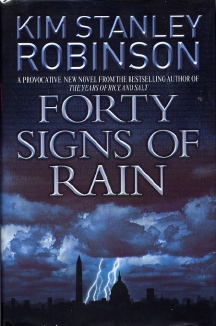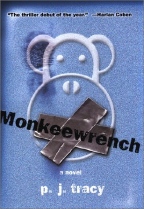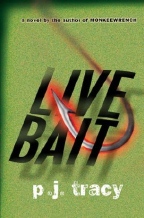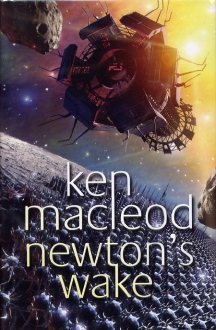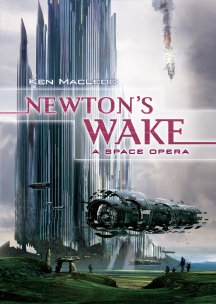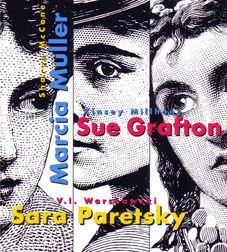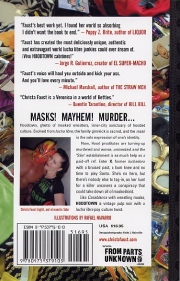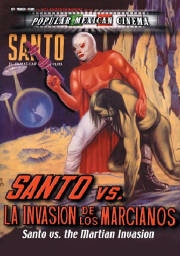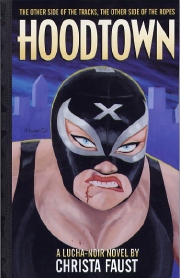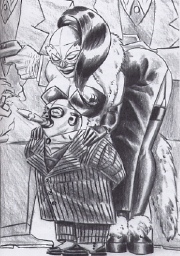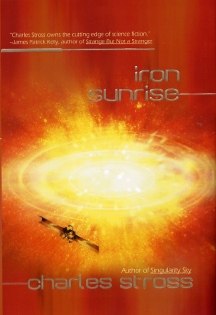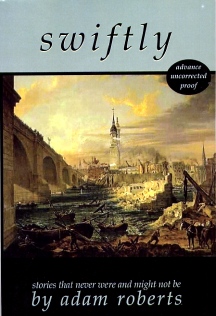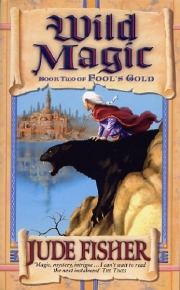|
|
|
This Just in...News from the Agony Column
|
05-28-04: 40 Signs of Kim Stanley Robinson; Fishing with 'Live Bait' |
|||||||
Rain, More Rain and the End of the World As We Know It
Robinson's latest novel reads surprisingly like Tom Perrotta's 'Little Children', with a heavy-duty realistic scientific spin. Charlie Quibler is a stay-at-home dad who emails in his recommendations to Senator Phil Chase vis a vis the perils of climate change. His wife, working for the National Science Foundation, also navigates the perilous shoals where the reality of science meets the unreality of politics. Robinson writes in a style that is both scientifically and character oriented. That is, his characters are scientists and their thoughts are unspooled with a realism not often found in fiction. I'm also looking forward to reading Robinson's take on science and politics. We've recently seen an increasing politicization of science. It's a really contentious area that weighs heavily on current events and impacts all of us every day. The very subject about which Robinson is writing is the focus of an increasingly bitter and political struggle. For those of who grew up on the idealized science of Arthur C. Clarke and Isaac Asimov, what's happening to science today is akin to a disaster with equal or greater impact than those predictions by the gloomiest of climatologists. If the tool with which we chip away at the structure of the world -- science -- becomes corrupt, what hope can we have of averting even the most minor disaster? What hope can we have of achieving the goals that feature in our dreams? The order of the day in '40 Signs of Rain' is climate change, and alas, just in time for this year's perhaps fun but forgettable movie 'The Day After Tomorrow'. Be that as it may, the reading experience provided by Robinson's novel promises to be powerful and intelligent. Robinson has been covering a lot of ground since finishing up his Mars trilogy -- 'Red Mars', 'Green Mars' and 'Blue Mars', themselves often mentioned as potential candidates for adaptation by no less than James Cameron. But if you've read the novels, then you've already experienced more than the movies will ever be able to show you. |
|||||||
PJ
Tracy Throws a Monkeewrench in Your Plans to Jettison Serial Killer
Fiction
For readers who slather over serial killer narratives, the Tracy books provide five-star, gourmet slather-fare. For those readers who, like me, roll their eyes and yawn at the mere thought of yet another serial killer novel, well, I can only suggest that you put your well-founded prejudice aside - just this once - for the Tracy books. The writing is crisp, energetic and very funny; all the characters, geeks, cops, men and women, are exceptionally well-developed, colorfully quirky without edging into cutesy or coy; and the plot both gels and propels. The Tracys blend classic, fast-paced crime writing with modern techno-geek jargon that’s cyber-savvy but not cyber-shopworn. Computer video games and sophisticated crime-cracking software are pivotal to the plotting and characterization, but the techno element is held nicely in check, energizing the story but not overwhelming it. If ‘Live Bait’ is anything like ‘Monkeewrench’, and the early buzz indicates it may be even better, then these two ladies have bestowed upon us yet another winner. Terry D'Auray
|
|
05-27-04: Celebrate the End of Physics as We Know It in Newton's Wake |
||||||
Ken Macleod's Latest Standalone Space Opera
In terms of books you can easily recommend to a friend Macleod was a bit difficult -- but no more. He's just turned in his first standalone space opera, 'Newton's Wake', and while it has all the hallmarks and quirks of his earlier work, it does seem a step closer to the mainstream. Now, you'll still need a good telescope to see the mainstream from the edges of 'Newton's Wake'. Macleod's storytelling style is a curious mixture of the utterly impenetrable cross-cut with the crystal clarity of stunning invention. But in any event, 'Newton's Wake' is an excellent way to start readers down the path to Macleod's other work because it works all by its compact self.
Macleod is also blessed with publishers on both sides of the pond who bother to get fantastic cover illustrations for the dust jackets that are quite pertinent to the scenes in the novel. The UK cover shows a ship named The Hungry Dragon gliding over a field of its own creation amidst the asteroid belt in the solar system of the planet Eurydice. The US cover shows a vision of a battle around the relic on Eurydice. Both are right out of the novel. Since I'm currently reading this novel -- I'm almost done -- expect a review early next week. The short version is that you should find your copies now, especially if you've not read Macleod. Of course the usual warning applies. You'll be about halfway through this novel when you start searching for the rest online. They are all available as attractive mass market paperbacks. But you're not going to settle for that, are you? You're going to need hardcover first editions. Sorry. Well, at least they're attractively designed books. |
|
05-26-04: Women of Mystery, Christa Faust Goes to Hoodtown |
||||||||||||||
Grafton,
Muller, Paretsky on Film
Well, that's all of them, right? Apparently not. Briggs made this film a labor of love and time. It took her over eight years to conceive, film and complete the nearly one-hour look into the writings and thoughts of mystery writers Sue Grafton, Marcia Muller and Sara Paretsky. The film itself weaves interview segments, insights into the writing process and re-creations of scenes from the novels. It's rather beautiful, filmed on sunny, windy days in grassy, natural locales and the rough urban settings of the novels. Sara Paretsky in a hard hat? You've got it! Particularly interesting is how Briggs gets each writer to talk about her relationship with her heroine. The splits and seams, the differences and the similarities between these talented writers and their creations offer viewers -- presumably readers -- insight into the novels that you're not going to get outside of a good interview. The combination of these three women, who all helped to create the US modern hard-boiled woman detective mystery allow viewers to make connections between the three that might otherwise be missed in individual interviews. So can you see this movie at a movie theater, one of your nice little art-house deals? Nope. Can you see it where it belongs, say on PBS, where the viewers are largely readers? No; the PBS board split over whether they wanted to show it and backed out. It makes no sense to me, having seen the film. This is precisely the kind of thing that PBS should be showing; work that aims at a large audience but is thoughtful and literary. Think of the huge fan base of these three writers; all of them are bestselling writers. That's millions upon millions of viewers. And readers are certainly willing to watch movies about the writers we read. Something like 'Women of Mystery' enhances the reading experience of these three writers significantly. The visualization of the writers gets into the readers' brains and informs the Storycode engine that turns the viewing of a series of sequential words into the reading experience. So how did I manage to see this movie? The Friends of the Santa Cruz Public Libraries, that's how. Let me say this again: The Friends of the Santa Cruz Public Libraries, that's how. In this day of commerce-driven reading, where every book is measured in terms of sales to end-user readers, there's another sales figure that's probably more important to readers in general and the author of any novel; the sales of a book to the public libraries across this nation. I come by my habit of stacks of books via my father, who was a voracious reader and had stacks of his own -- from the library. Yes, I've taken this to the next, obvious, obsessive level, and many of my readers have as well. That's all well and good, but it's important to remember that not everybody has the wherewithal to spend as much money on books as we do. And we might want to sample some authors before making the push to say, buy a complete set of first editions of a writer with whom you are not familiar. I asked Pat Sandidge, the managing Director of Friends of the Santa Cruz Public LIbraries, how she heard about the film and came to put the event together. She told me that, "FSCPL first heard about it a year ago from Center for The Book info which is administrated by the CA State Library. Then Laurie King offered to work with us, and I contacted Pamela by writing to the distributers of the film who gave me her name. The Friends Board decided to make it a combination Annual Meeting Program; Membership Drive, and Fundraising Event. The Nick [the Nickelodeon, the Santa Cruz art-house theater where the film was shown] generally does an appropriate film event every 18 months or so and was able to handle the 16mm film." The presentation of 'Women of Mystery' by The Friends of the Santa Cruz Public Libraries included not just the movie, but a wonderful panel discussion afterwards with Laurie R. King, Marcia Muller, Shirley Rosseau Murphy, and filmmaker Pamela Beere Briggs. The insights we gained from the film were enjoyably expanded by this panel discussion, which included questions from the audience. This is movie-going as it should be. Seeing 'Women of Mystery' wasn't just a passive experience. To even be interested in the subject, you had to have read the authors work. You were already many, many hours into the subject. Once there, we saw the movie, then turned up the lights in the theater and saw one another. Imagine that! We saw the writers -- not just those in the film but others as well and were able to ask them questions. It was a completely involving experience one that will keep unfolding as we, the audience, read these writers' works in the future. Instead of sit and forget, we all participated and pondered. This is the quantum difference between movies and books, and here's the rare example where the two each use their separate strengths to enhance the experience of each medium. Get to your library, help them set up a showing of this movie. Here's a link to New Day Films website to help you get going. But first, if you haven't read these authors, then get to your library, check out one of their books and read it. That's a fine start. |
||||||||||||||
Masked Wrestlers and Lucha-Noir Vengenance
It's Christa Faust, or rather X, the former luchadora wrestler fighting now for justice for Hoodtown. 'Hoodtown' is Faust's second novel, and this looks like a rockin' good time. It's one of those books I want to pick up and read from cover to cover without stopping. Faust has a strong, entertaining voice. She's a natural born killer storyteller, and this story looks to be right up our alley. Hoodtown is the ghetto of masked wrestlers, a place where they create their world and live by the rules of the ring. But when Hood prostitutes start showing up dead, and worse -- unmasked -- the 'Skins' won't lift a filthy finger to help. That's why X takes it upon herself find out who is doing the killing; because it's not just the women who are threatened but Hoodtown culture itself. For those who have not yet gone to Faust's website, here's the perfect opportunity to do so. You can read a hot-scary piece of crime fiction for nothing here. Once you've recovered your wits -- give yourself some breathing room, Faust is a powerful writer who will strike a heavy blow -- you can start thinking about finding this novel, which spears just as tough as nails, but perhaps a tad more lighthearted in execution. I believe that there will be some executions in this novel, at any rate. You can find the novel at the website of new publisher From Parts Unknown. FPU specializes in lucha loot; there is a DVD of 'Santo VS. La Invasion de los Marcianos', which looks to be a Lucha version of Santa Claus Versus the Martians. Do I really have to go any further? OK, I will. Not only is Faust an excellent writer who will turn in a toe-curling tale of terror for you, you'll also get -- at no extra charge -- illustrations by Rafael (Sonambulo) Navarro! You'll get a nine page glossary of Hoodtown slang for nothing! Take that, Anthony Burgess/Clockwork Orange Fans! And how, I ask you, can you resist a novel from a writer who describes herself like this: "She enjoys vintage high heels, the renowned SoCal Lucha scene and tying women to train tracks." You can't; because if you think you can resist, well, when you next wake, remember that light at the end of the tunnel. It's a train. |
|
05-25-04: Greeting an Iron Sunrise |
|||
The
New Novel from Charles Stross
'Iron Sunrise' begins when the peaceful planet New Moscow is destroyed by the explosion of its sun. Doomsday weapons launch an automatic attack on the presumed culprit -- the neighboring system of New Dresden. But New Dresden didn't do it. Rachel Mansour is called to find out who did what and when they did it, and to stop the destruction of New Dresden. There's a new enemy out there, one that can bring down not just New Moscow and New Dresden, but the Eschaton -- an all-powerful AI that currently runs the universe and usually manages to keep mere humans armed with science more powerful than they can comprehend from undoing reality. Only Wednesday Shadowmist, a disaffected teenage survivor of New Moscow knows the enemy. But she doesn't know that she knows. Charlie's novels have a sort of crazy quilt, kitchen sink feel that's loose and lots of fun. 'Singularity Sky' will be a mass market paperback on June 29, giving you just enough time to buy it and read it in paperback before this sequel comes out on July 6. (Though you'll regret not buying the hardback, it's OK, you can buy a hardcover after you've handed off the paperback to a friend.) Stross is an easy entry on the auto-buy list, something we're gearing to talk about here on The Agony Column. |
|
05-24-04: In: Adam Roberts Debuts in the US, Jude Fisher goes from Publishing Tolkien to 'Wild Magic' |
|||
'Swiftly'
from NightShade Books
Roberts' US debut is a collection of short stories and novellas titled 'Swiftly' from Nightshade Books. For readers who enjoy Roberts' work this collection is a treat, because only two of the pieces have appeared anywhere else; the title story appeared at scifiction.com and the novella 'Jupiter Magnified' was issued last year as a PS Publishing novella. That makes this collection a must-buy for Roberts' readers because most of it is entirely new. And as much as we love scifiction.com for publishing such great writers at no cost to readers, the whole "real paper and pages" thing makes the book's version of the title story a welcome addition. Roberts shows more range here than those who read his science fiction will expect. 'Allen Met the Devil' is a Twilight-Zone style classic that will make readers wish it could get the adaptation it requires. It's funny, simple and harsh in the ways that Roberts' science fiction manages without the SF backgrounds. 'Swiftly' is a dark piece of steampunk horror, carefully written and controlled as are all Roberts' work. For those who are wondering, yes, Roberts does in this collection actually violate his convention of titling a story with the first words of the story. But only with some of the shorter works. Others, he keeps firmly in line. Those who enjoy Roberts' more meta-fictional stylings will appreciate 'The Question of [query term]' and 'New Model Computer', both of which allow him to sharpen his academic knife and slice open and blend techno-fact and fiction. And because readers like me want a nice big meaty chunk of fiction, he follows up 'Swiftly' with the novella-plus-length story 'Eleanor'. If you've wondered about Roberts from afar, Nightshade has the solution: this collection of stories will swiftly have you seeking the rest of his fiction. |
|||
'Fools'
Gold Part 2
In this case, once you crack the cover, you'll find that Johnson co-wrote a series of novels with none other than M. John Harrison, whose 'Virconium' novels are accepted as classics in the genre and whose 'Light' was certainly one of the highpoints of 2002's fiction. My take is that anyone who has worked with Harrison is certainly worthy of your time and attention. And that's one of the reasons I write this damn column and all this news, to sift through certain trash that turns out to be potential treasure. The problem is that I have to constantly battle my own inclinations, which, when I see a caped guy on a cat, say, "Not for you, Rick." I admit it; I immediately set this aside. Then, for reasons even I don't know, I took another look, and understood; there is something here, something worth reading. So if you're looking for a big fat character-laden novel of magic returning to the world, then Fisher seems like a pretty solid bet. You will have to battle the cover, but you know -- you're not reading the cover. You're reading the 565 pages between the cover. The world it depicts may or may not have magic. The world you reside in is certainly low on magic. But there -- on the printed page, in the process of reading -- that's where the magic really begins. |
